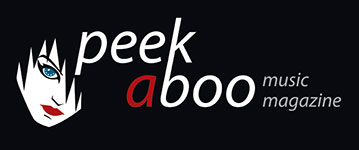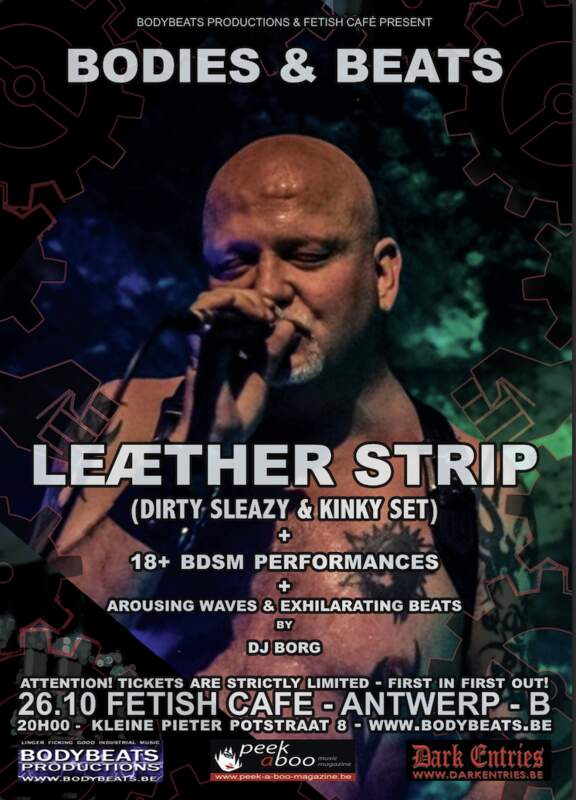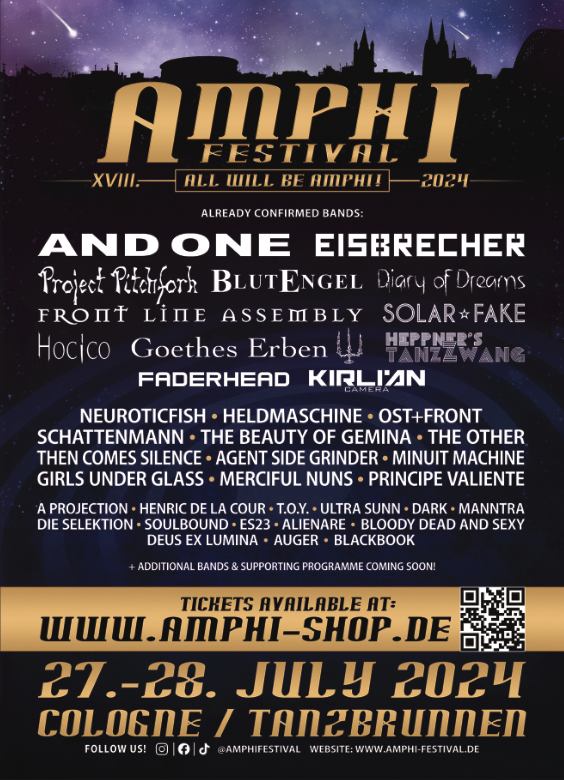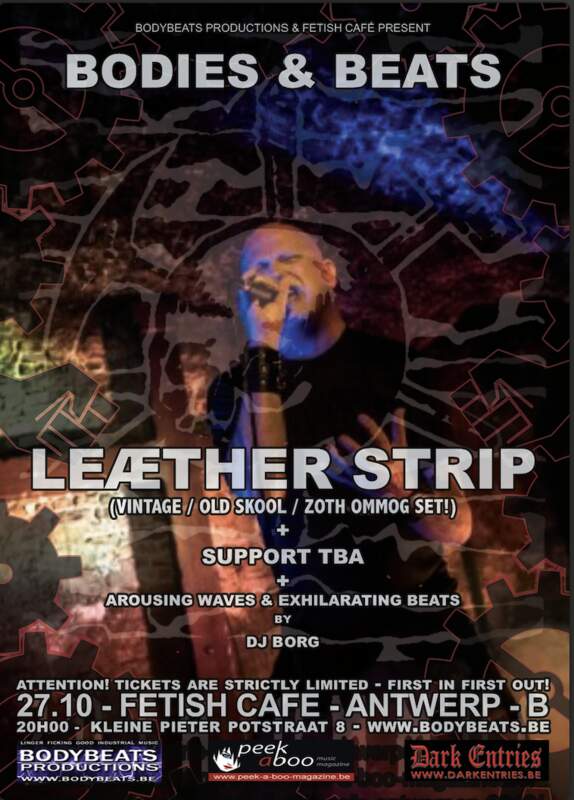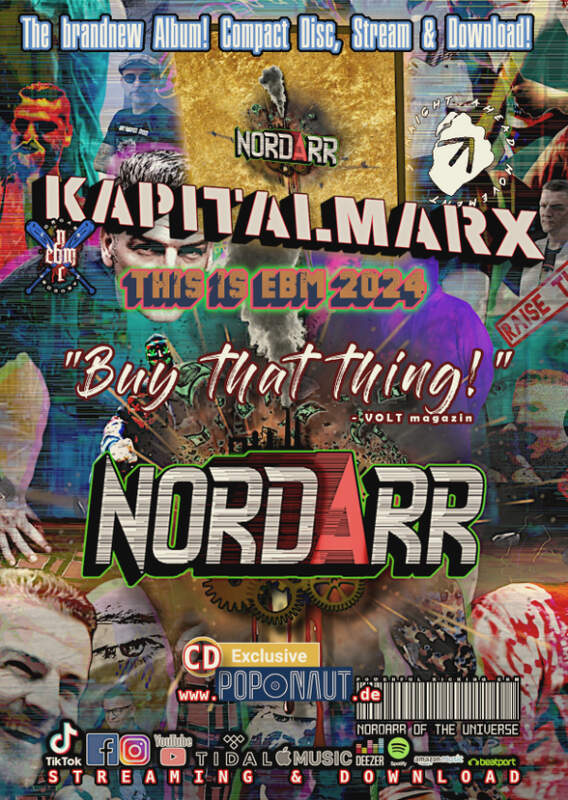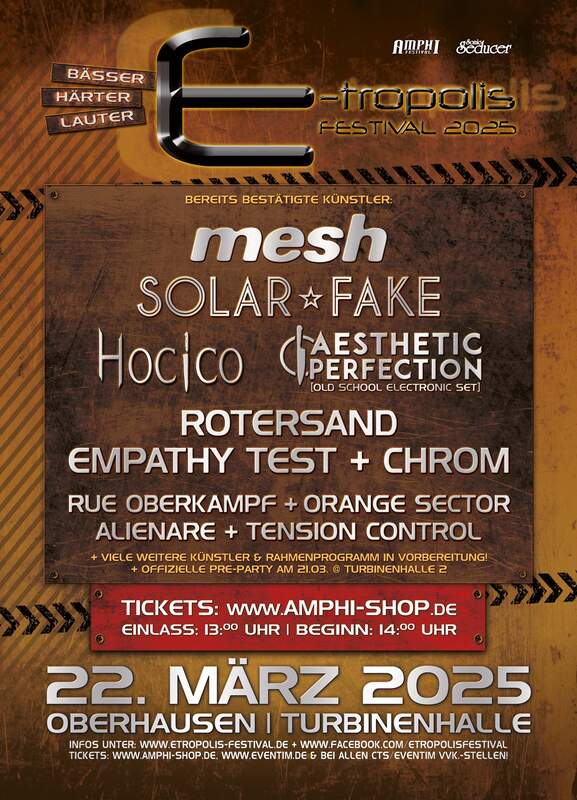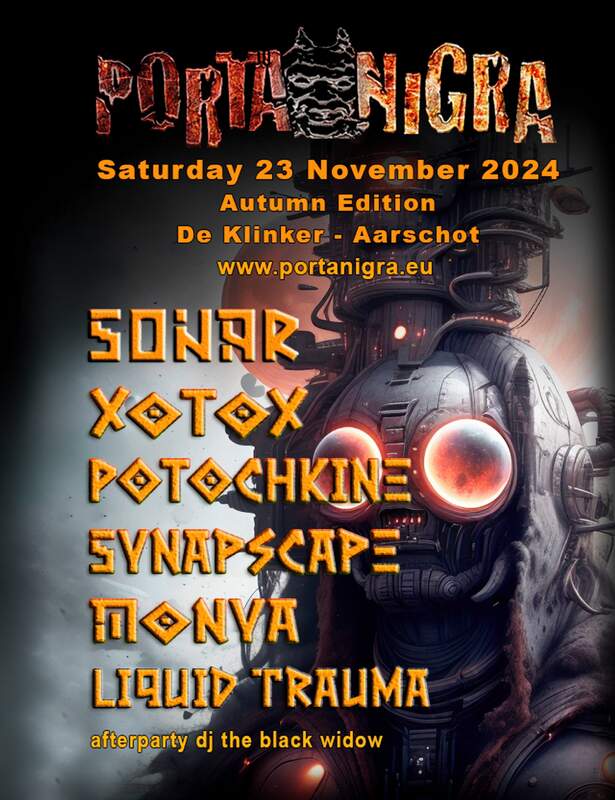ALEXANDER NYM (NSK STATE IN TIME)
If you’re marching towards annihilation, you should at least do it with a happy song.
23/10/2023, Xavier KRUTH
“Become a citizen of the first global state in the universe!” With this sentence in the 1994 Laibach clip for ‘The Final Countdown’, they announced the existence of the NSK State In Time, an artificial state without borders of which anyone could become a citizen. The state actually emerged in 1992 and was a response to the disappearance of Yugoslavia, a socialist utopia that managed to get different peoples and ethnicities to live together in a dictatorship. The break up of Yugoslavia was accompanied by several wars, which became the subject of the 1994 Laibach album ‘NATO’. In 1995, the NSK state declared the besieged Sarajevo an NSK free state for a while and although there are several other episodes with temporary embassies, the state has no territory. The NSK State only exists in time.
NSK State In Time has an earlier history. NSK was founded in 1984 as Neue Slowenische Kunst, an artistic collaboration dedicated to the study of art and ideology. That was a response to the ban on the Slovenian industrial group Laibach. Laibach owed the ban to provocative performances in which they ‘over-identified’ – according to a statement by the Slovenian philosopher Slavoj Žižek – with the Slovenian and Yugoslav rulers and their totalitarian utopia. NSK then consisted of Laibach as the musical arm, IRWIN as the visual arts arm and Scipion Nacice Sisters as the theatre arm. In 1992, the art movement transformed into the NSK State In Time, which continues to evolve to this day.
Alexander Nym has compiled a new book about NSK State In Time: ‘Weapons Of Mass Instruction. Speeches, reports & Documents From NSK State In Time’. In addition to many texts by Nym himself, you will find many documents and speeches that illustrate the history of the NSK state after 2010, i.e. after the citizens took over the management of the state from the founders. Nym has previously published books about Laibach (Alexei Monroe: ‘Laibach und NSK. Die Inquisitionsmaschine im Kreuzverhör’, 2014), Death In June (Aldo Chimenti: ‘Verborgen unter Runen’, 2012), the WGT in Leipzig (‘Black Celebration. 20 Years Of Wave-Gotik-Treffen’, 2011) and especially the beautiful ‘Schillerndes Dunkel’, an impressive and beautifully illustrated collection of articles about the gothic scene from 2010. We submitted Alexander Nym to an interrogation about his latest book.
Hi Alexander. You have just released the book ‘Weapons Of Mass Instruction. Speeches, Reports & Documents From NSK State In Time’. What was your motivation for releasing this book?
Starting with the Citizens’ Congress in Berlin in 2010, NSK State has taken on a life of its own, even more so than before. Numerous citizen activities have taken place since, starting with the NSK Rendez-vous in France, to various exhibitions and other gatherings in the UK, the US and elsewhere, culminating in the series of impressive NSK Folk Art Biennales in Leipzig, Ireland and Trbovlje in Slovenia, where it all began in 1981 (the town where Laibach originated from, xk).
Since due to the spatial distances involved, attendance was not possible for all interested citizens around the world, I figured that a collection of the speeches given and the documents involved in these activities, would provide interested citizens with the opportunity to read up on these events and developments. Thus, I began expanding my archive and started collecting those bits and pieces to present them in an appealing and informative fashion, not only for citizens of NSK State but also as a documentation of the State as such.
To understand the NSK State In Time, we should go back in time. Neue Slowenische Kunst – abbreviated to NSK – was founded as a multidisciplinary art movement in 1984, as a consequence of the banning of the industrial band Laibach in Slovenia, then a part of Yugoslavia. What was the context and the resonance of the founding of this artistic movement?
A complex question! For anyone interested in the painstaking details of NSK’s history, I recommend Alexei Monroe’s book ‘Interrogation Machine’.
In short, when NSK started out, it functioned as a beacon for subversive artists in Slovenia and overall Yugoslavia at the time, effectively providing a platform that would soon provide international exposure. It thus produced the bizarre effect that Laibach, Irwin etc, were able gain a reputation outside of Yugoslavia, while they were struggling for recognition at the home front.
The mere structure and appearance of the NSK movement or school suggested a state-like penchant for organization, which effectively superseded that of the slowly fading mothership Yugoslavia. In a period when Tito’s multinational state was disintegrating, NSK presented Slovenian culture as both an amalgamation of centuries of cultural and political interpellation, as well as a (future) independent country. By juxtaposing Slovene national symbols with totalitarian imagery, NSK effectively coopted iconography which might otherwise have been adopted by the Slovene nationalist far right.
In retrospect, this may have effected a far less aggressive nationalism in Slovenia than in other Yugoslav federal states, preventing Slovenia from joining in the slaughter that was to follow.
In 1992, the NSK ceased to exist as an artistic collaboration and transformed in the NSK State In Time, the first global state in the universe of which everyone could become a citizen. What prompted the founders of NSK to this transformation and what was the significance of the new state?
Since NSK’s prediction of an independent Slovene state had become a political reality by the beginning of the 1990s, it had become obvious that NSK’s ‘mission’ had been accomplished. Regarding themselves as artists in service of a utopian state that by its very nature could never exist in reality, NSK decided to push their approach a step further by joining the numerous newly (re-)founded nations emerging from the disintegrating Eastern bloc by creating a state of their own state, unlimited in time and regardless of territory. By creating this State In Time, NSK practically predicted and practiced the increasing connectedness and global information systems emerging during in the 90s.
With the exception of your introduction, the book highlights the functioning of the NSK State after 2010, the year in which the first citizens congress of the NSK State took place. It is now said that the citizens took over the state during that congress, though I have a feeling that this is an interpretation in retrospect. Is that correct? What was the importance of that citizens congress?
You are right. NSK citizens had of course begun to organize events and projects well before the Congress. The Congress as such was both a manifestation and celebration of these grassroots activities, as well as a call to arms for citizens to take the state into their own hands. Considering that NSK State had been founded as an experiment in basic democracy, handing over the state to its citizens was the logical move. It was done in order to shift responsibility and initiative away from the original NSK groups, towards the citizenry.
Alexei Monroe describes the NSK State project – and, in fact, the entire Laibach enterprise – as a chain of improbable events and developments, leading to results even the founding fathers and mothers couldn’t have anticipated in 1992. Thus, I retrospectively regard the Congress as a turning point in NSK history, ushering in the next phase of NSK-related activities, yet with little to no involvement of the Slovene groups of the 80s.
The book contains a lot of illustrations, as well as texts in both English and German. How did you select the texts and illustrations you would include in the book?
I started out with the concept of ‘Reden’ (speeches) given at the various events. Collecting those was the first task. I also looked up other writings which had either been previously unpublished or only available to limited circles, or for a limited time – e.g., many online reports that had vanished from the www in the meantime –, or scripts for interviews, pamphlets of various NSK State denominations etc, which were part of live events or collecting dust in cupboards and on hard drives, and were thus not yet documented properly. Out of the material gathered, the overall structure of book began to reveal itself.
However, it wasn’t possible to access all the archive material I was aiming for, so there are still a few gems hidden in the vast bureaucratic vaults of NSK State.
In selecting the images, I was keen on including as many pictures from NSK State events as possible. However, not all of them were up to the technical demands of print. I had to hunt down the original high resolution images, which weren’t always available.
In terms of NSK Folk Art, it was much easier since our citizenry is not only creative but collaborative in the best sense of the State’s collectivist approach. Otherwise, a good deal of NSK State exhibitions couldn’t have been set up without the superstructure of the art world and its gatekeeping mechanisms, like access to gallery spaces, grants etc. NSK State is able to raise such resources out of its own being, not only enabling DIY artists access to public attention through the NSK framework, but also short-circuiting the ‘traditional’ ways of setting up exhibitions and performances.
How do the citizens of the state keep the project alive now that the founders of NSK have more or less retreated? Is there a coordination of all the activities done in the name of the NSK State In Time?
No, there clearly isn’t. Basically, anyone can set up an NSK State event and hope for the support of the citizenry. There are no official authorities to permit or prevent citizens from acting in the name of the state. However, this doesn’t mean complete anarchy either, since the formal structure and operating procedures of the state – its working ideology, if you will – provides a pretty clear framework in terms of both content, form, or techniques. They require an understanding of the neuro-political foundations of NSK and the state, the absence of which would be felt heavily by citizens. Thus, the only formal censorship applied by the state would be the individuals’ decision to ignore what doesn’t strike them as being ‘NSK enough’.
However, since emphatic eclecticism is a basic NSK strategy, I predict there will be no lack of material for future generations of NSK citizens to appropriate, sample, and juxtapose, so the aesthetic building that the state has created is open to any style, theme or approach.
NSK State In Time has a myriad of activities. You have the production of typical ‘folk art’, of which there are exhibitions and biennales, beside congresses, scientific articles, books, rendezvous’, manifestos … What connects all these different artistic and academic expressions?
You mean, besides the common kernel of somehow relating to a Slovene artist movement of the 80s? Frankly, I don’t know. Many of these contributions have come from scholars, researchers and scientists who are not citizens of NSK State and can thus be read as an outside interpretation of whatever topic is dealt with in particular.
On the other hand, many journalists, academics and deciders in the art world are in some way affiliated with NSK and/or the state, whether or not they formalized their kinship by becoming actual citizens. In the end, what connects them all is certainly the interest in and enthusiasm for an alternative, art-inspired way of life and the colonization of previously unexplored regions of the mind; the curiosity to find out if there can be alternatives to the Western mode of suicidal capitalism. Ultimately, we are all inspired and attracted by that most lofty of NSK authorities, the Immanent Consistent Spirit. (The Immanent Consistent Spirit already appears in early organizational charts of Laibach and NSK as a kind of ‘spiritual presence’ that stands outside the actual structure of the movement, but influences it integrally, xk)
NSK State In Time discusses several important issues. Migration, perhaps the most sensitive political topic nowadays, was often debated since the founding of the state, and was even the main subject of the NSK State Pavilion at the Venice Biennale in 2017, which is extensively quoted in your book. What can the NSK state teach us about migration?
What can a state that knows no territorial borders teach about migration? A state that issues passports to anyone, regardless of their geographical location or place of birth, thus welcoming immigration as a means to grow and expand?
Having prefigured the emergence of the digital domain and the global connectivity it provided, which is basically a means for corporate capital to create new markets, NSK State may as well have prefigured the way we’ll have to think about migration in the future.
Humanity is all living in the same house, planet Earth. You cannot have one part of the family live on the sun terrace upstairs, having barbeques and partying away, while another part is locked in the basement, drowning from floods and rising sea levels. That’s not only immoral, it is also unwise and impractical, as those floods will destroy the entire house eventually. Only in collaboration lies the key to human survival in the face of our own demise.
NSK is controversial because of the use of totalitarian imagery in art. Even if this method – often labelled as ‘over-identification’ with totalitarianism – is used since 1980 by Laibach and NSK, it can still cause scandals. You told me about an artist in Bavaria who was sentenced before court for allegedly portraying the Bavarian Minister-President in a uniform resembling an SS-uniform. What is the trouble is about?
As you may know, Germany has introduced laws after WW2 to prevent Nazi symbols from being used to reinvigorate the politics of the German ‘Reich’ of the 1930s and 40s. On the other hand, Bavaria introduced laws providing police with means to arrest people on the basis that they MAY commit crimes – pre-crime, if you recall “Minority Report” from 2002 – in order to prevent supposed Islamist terrorism. Yet like any proper power-grasping state, this was first used in practice to jail climate protesters without charge, for weeks, since they are much worse than fundamentalist mass bombings, obviously.
Also, the mere act of passivity towards police arresting you is no more simple resistance but counts as an attack on officers – with the unsurprising steep rise in statistics recording such supposed ‘attacks’. We are witnessing the slow transformation of Bavaria and other German federal states following this authoritarian model into police states.
The artist in question, Fabian Zolar, created a large open-air graffiti – legally, I should add! – of police brutality. It was a reaction to him and his brother having been beat up and abused by officers. Remember: don’t even defend yourself or you’ll be declared an attacker! The graffiti was crowned by a portrait of a uniform-wearing, half-decomposed head (partly a skull, xk) that reminded certain people of the Bavarian prime minister. Upon this, the Bavarian chancellery in Munich, by order of the prime minister, charged Fabian with defamation and use of anti-constitutional symbols, punishable by the aforementioned anti-Nazi-law.
The scandal here is not that a politician was supposedly portrayed as smiling at the scenes of police brutality – currently, investigations are being led against the officers in question, but rest assured that there will be no legal consequences for them -- , but that the court denied that the work is actually a piece of art!
A state where judges decide whether or not something is art has definitely left the grounds of the German constitution, even if Bavaria does indeed have an individual constitution. Fabian will have to defend himself through all instances until a federal court takes up the case, as chances are slim to find a judge in Bavaria with the guts to tell Herr Söder and the Munich chancellory to fuck off and behave like professionals, instead of conjuring up the Streisand effect by abusing the judicial system in order to satisfy Herr Söder’s vanity and fragile ego.
They are turning a formerly anti-Nazi-law expressly disregarding artworks into a tool to suppress justified artistic criticism on a flimsy legal basis. If the court’s rule stands, ALL depictions of skulls in Bavaria must therefore be regarded as SS death’s heads. Every depiction that Herr Söder doesn’t like can thus be denied the status of artwork. These are assets of dictatorial regimes but certainly not of liberal democracies.
Bavaria, Saxony and a number of other German federal states headed by the prime ministers dreaming about becoming some mini-Orbàn, are on a steep and very slippery slope regarding the validity of our constitutional rights; a trend I’ve termed ‘soft totalitarianism’ in the 90s.
In September 2023, you will curate an exhibition called ‘Neue Bajuwarische Kunst – Reliquien, Devotionalien, Ergebenheitsadressen, Volkskunst’ at the Kofferfabrik in Nuremberg. What should we know about this exhibition?
First, it involves a great deal of non-Bavarian artists and immigrated ones as well. Second, there will be a good deal of cartoons and caricatures on display, hailing Söder as Jesus reincarnated, delivering us from the yoke of democracy. We need no civil rights in Bavaria because we are subjects. The exhibition aims at celebrating this in the most enthusiastic way possible. For if you’re marching towards annihilation, you should at least do it with a happy song, while you still can.
There are a lot of other activities associated with NSK in the coming months. You went to the première of Laibach’s Alamut symphonic multimedia spectacle, based on a Slovenian book from the interbellum but there’s also an exhibition on 40 years of NSK-founders and visual artists IRWIN at the HMKV in Dortmund, and your book is only one in a list of books that are announced. Can you tell us more about all these events?
Sure. The ‘WAS IST KUNST, IRWIN’ exhibition will also be documented by a lavish catalogue. Since yesterday, it is also possible to order the fantastic book by NSK State Reserve New York, entitled ‘FIAT – All Money Is Ours’ from PC Press in the UK. The hardbound edition has a 350-copy print run and early birds can get some additional goodies, so get your hands on it while it’s available.
In October, Slovenia is the featured guest country at the Frankfurt Book Fair, which is why Laibach are embarking on their ‘Alamut’-mini-tour there. This is occasion enough to supply NSK enthusiasts with an altered and expanded new edition of what will be called ‘Kunst-Maschine – Essays on the Gesamtkunstwerk Laibach’, edited by Uwe Schütte and featuring an in-depth report on ‘Alamut’ written by yours truly, available soon from Austrian publisher Drava.
Uwe also edited a collection of Peter Mlakar’s speeches, philosophical treatises and (sometimes pornographic) short stories, including both Peter’s original books ‘Reden an die deutsche Nation’ – the title of which inspired my own “Reden an die Europäische Nation’ – and ‘Genießen und Nichts’, complete with the recent speeches he gave for various Laibach performances since those books were published. It is called ‘Festung der Metaphysik’ and will be available from the Austrian publisher Passagen soon. (Peter Mlakar is the head of The Department of Pure and Applied Philosophy of NSK, and is famous for his speeches, especially those introducing Laibach concerts, xk)
After having done my part to ‘spread the word’ on these immediately upcoming works, let me risk a sneek peak into 2024. Without giving away too much too soon, we’re looking at the 40th anniversary of NSK’s foundation in 1984, and thus the 40th anniversary of legendary NSK design studio Novi Kolektivizem … let’s see what that will entail.
And it’s about time for a revelatory look at Laibach’s genesis and life over four decades, something that might not even be out during next year, considering the amount of material to deal with and the fact that most of the original artworks, like record sleeve designs, poster art etc, have been lost over time. Which is why we’re going to see a number of re-designed and expanded Laibach re-releases and possibly a coffee-table-sized art book to tie into that.
Yet, as is the case with all things NSK-related, unforeseen quantum fluctuations may very well interfere with our feeble-minded human brains and each project takes exactly as long as it requires to finish, so for the time being, I can’t possibly reveal any further details without destabilising the gestating process.
In the meantime, I’ve set up a number of literary events also featuring NSK(-State) stuff:
- November 2023: ‘Kunst-Maschine’ and ‘Festung der Metaphysik’, featuring Uwe Schütte -- Laibach-Literatur (I)
- January 2024: ‘FIAT – All Money Is Ours’ and ‘Weapons Of Mass Instruction’, featuring Charles Lewis (NSKNY) via live stream -- Laibach-Literatur (II)
These events will take place at Nuremberg’s Künstlerhaus on Deck 2 and are slated to start at 8pm. At Halloween and Winter Solstice, my comrade Lars Kamping and I are going to present Gothic Horror stories and fairy tales/myths/legends, respectively – less NSK, more scary and fantastic stuff, and probably more appealing to a Goth audience anyway!
Who knows, we may even see another edition of the NSK Folk Art Biennale next year, or in 2025, if some citizens are up to the mission and decide to make it a reality. Right now it seems that NSK State as well as the founding groups are recovering fine from the Covid-period. It seems like cultural activities in general are on the rise again, though I expect it’ll take years until we’ll reach pre-Covid turnouts again. So far, that’s all I can tell you, and anything beyond that is currently remaining obscure, hiding in the domain of improbability. Yet, WE ARE TIME, and the future unfolds itself into the past (‘We Are Time’ refers to the ‘WAT’ album from Laibach in 2003, xk). Patience is a virtue and we of NSK State have learned to use it as a weapon.
Xavier KRUTH
23/10/2023
Xavier KRUTH
23/10/2023
Next interviews
DER KLINKE • We have grown into a very strong band live, which means that the demand for performances also grows.
PORNO KARAOKE • Some songs and artists deserve a bit more respect than others... Hahaha
ENZO KREFT • The fate of humanity rests in the hands of villains who will not hesitate to drag anyone into their fall.
PSYCHE • The DarkMAD interview
DIRK DA DAVO • Retrospective
MONSTERGOD • With their most recent release “Ozymandias” Monstergod prove that dark sounds and poetry may go hand in hand to reach the effect that is both mesmerizing and dynamic in the most excellent hard-hitting way.
OK LION • I didn't convince Patrick Codenys to work with us, it was his idea!
DERISION CULT • An Interview With Dave McAnally of Derision Cult
THE JUGGERNAUTS • Let’s leave the love dramas and (fake) feel good theme to pop music and the brain dead Tik-Tok generation.
PSY'AVIAH • Wanting to have everything under control is problematic, as is wanting to have nothing under control.

